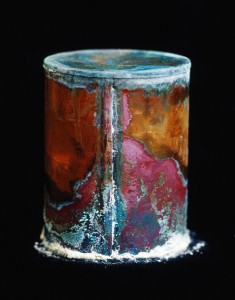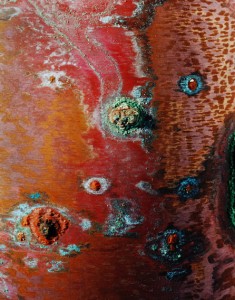

The majority of photographer David Maisel‘s work focuses on environmentally-impacted sites, which comprise a multi-chaptered series called Black Maps. His most recent collection, Library of Dust, looks at an intersection of aesthetics and ethics, displaying the simple beauty of death and natural transformation, and raising ethical questions without saying a word.
Library of Dust is a series of photographs that each depict an individual copper canister, which contains the cremated remains of a patient from a state-run psychiatric hospital. The bodies of the deceased patients were never claimed by family members, and the remains are now cataloged in a dusty room lined with simple pine shelves stacked three-deep with the canisters, which Maisel calls the “Library of Dust” based on the cryptic words of one of the hospital’s patients.
The lids of each of the thousands of canisters are stamped with a number, running from 01 to 5,118. The tattered remains of paper labels can be seen on the front surface of some of the canisters, but many have completely faded away. The canisters date back to 1883, when the facility was opened as Oregon State Insane Asylum, and up to the 1970s.
The facility, now called Oregon State Hospital, is located in Salem, Oregon. It was the site of the filming of One Flew Over the Cuckoo’s Nest, the movie based on the book by Ken Kesey. The hospital has seen intense controversy over the past decades, including charges of civil rights abuses to patients, and concerns about the cremated remains of the deceased patients. The facility is the subject of the documentary Guilty Except for Insanity, which begins screening this October in Oregon.
Maisel’s collection turns the spotlight on these controversal cremation vessels, highlighting the natural beauty that can be found behind the dust. According to the artist’s statement:
“Among my concerns with Library of Dust are the crises of representation that derive from attempts to index or archive the evidence of trauma; the uncanny ability of objects to portray such trauma; and the revelatory possibilities inherent in images of such traumatic disturbances. While there are certainly physical and chemical explanations for the ways these canisters have transformed over time, the canisters also encourage us to consider what happens to our own bodies when we die, and to the souls that occupy them.”

The canisters … encourage us to consider what happens to our own bodies when we die, and to the souls that occupy them.
The beauty and individuality of the canisters comes from the natural effects of secondary minerals on the copper, causing random blooms of color across their surfaces.
You can view the entire collection here.
photo credits

 Photographer Finds Beauty in Forgotten Cremation Vessels
Photographer Finds Beauty in Forgotten Cremation Vessels


 Losing Her Constant
Losing Her Constant
 Sky Lanterns Bear Wishes and Remembrance into Night Sky
Sky Lanterns Bear Wishes and Remembrance into Night Sky
 ”The Snow Sister” Directed by Cecilie Askeland Mosli
”The Snow Sister” Directed by Cecilie Askeland Mosli














